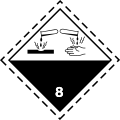Hydrochloric acid: Difference between revisions
CSV import |
CSV import |
||
| Line 25: | Line 25: | ||
{{stub}} | {{stub}} | ||
{{dictionary-stub1}} | {{dictionary-stub1}} | ||
<gallery> | |||
File:Phase_diagram_HCl_H2O_s_l.PNG|Phase diagram of HCl and H2O | |||
File:Hydrochloric_acid_30-33%_by_Danny_S._-_001.jpg|Hydrochloric acid 30-33% | |||
File:Stomach_mucosal_layer_labeled.svg|Labeled stomach mucosal layer | |||
File:UN_transport_pictogram_-_8.svg|UN transport pictogram for corrosive substances | |||
File:GHS-pictogram-acid.svg|GHS pictogram for corrosive substances | |||
File:GHS-pictogram-exclam.svg|GHS pictogram for harmful substances | |||
</gallery> | |||
Latest revision as of 11:01, 18 February 2025
Hydrochloric Acid is a strong, corrosive acid that is commonly used in laboratory settings and industrial applications. It is a clear, colorless solution of hydrogen chloride (HCl) in water.
Chemical Properties[edit]
Hydrochloric acid is a strong monoprotic acid, which means it can release one proton (H+) per molecule. It has a pKa of -6.3, making it one of the strongest acids. It is also a strong electrolyte, meaning it fully dissociates into ions in solution.
Physical Properties[edit]
Hydrochloric acid is a clear, colorless to slightly yellow liquid. It has a pungent, irritating odor and is highly corrosive. It has a boiling point of 110 degrees Celsius and a melting point of -27 degrees Celsius.
Uses[edit]
Hydrochloric acid has many uses in industry and in the laboratory. It is used in the production of chlorides, fertilizers, and dyes, in electroplating, and in the photographic, textile, and rubber industries. It is also used in the laboratory for the preparation of samples for testing, in the neutralization of basic systems, and in the titration of substances.
Safety[edit]
Hydrochloric acid is a highly corrosive substance and can cause severe burns and eye damage. It is harmful if inhaled and can cause respiratory irritation. It is also harmful if swallowed. Proper safety measures should be taken when handling hydrochloric acid, including the use of personal protective equipment and proper ventilation.









